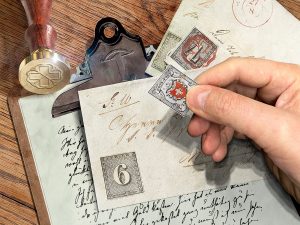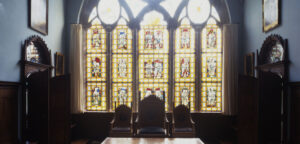
Dessau-Wörlitz Cultural Foundation
Prince Franz’s shopping spree
The German Prince Leopold III had a fondness for stained glass. On a shopping expedition to Switzerland, he purchased some valuable specimens which can be seen in Wörlitz today.
Zurich was a popular travel destination in the second half of the 18th century, famed for its picturesque location on the lake. Scarcely a foreigner who visited the city in those days didn’t pay a ‘visit’ to the pastor, philosopher and writer Johann Caspar Lavater (1741-1802). And there was scarcely a foreigner whom Lavater did not send to the Lindenhof in Zurich to see the statue of William Tell and his son Walterli. William Tell was the main protagonist in the old confederate freedom sagas and is considered an enduring symbol of Swiss freedom.
In summer 1782, Lavater and the German Prince Leopold III Friedrich Franz of Anhalt-Dessau (1740-1818), known as Prince Franz, met for the first time in Zurich. Together they travelled via Strasbourg to Karlsruhe to visit their mutual friend the Margrave of Baden. On the way they made a stop in Königsfelden, and in the church there they admired the empty tomb ‘of nine royal and ducal bodies and the painted window panes of the church’.
A year later, Prince Franz and his wife Louise arrived in Baden (Canton of Aargau). From there, they went on excursions to the Habsburgs, to Königsfelden and to Zurich. As the prince’s son wrote in his journal, his father left for Zurich on 13 August 1783 and didn’t return to Baden until the following day, with Johann Caspar Lavater and his wife. The prince ‘brought back a large quantity of painted glass panes for windows, the viewing of which kept us entertained for a time’. The prince travelled to central Switzerland and bought ‘sundry old painted window panes’ along the way.
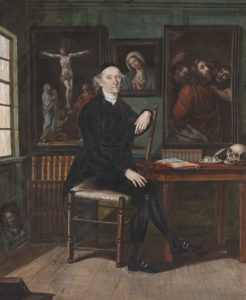
Johann Caspar Lavater in his study. Painting by Antonio Orazio Moretto, around 1798.
Swiss National Museum
HUNTING FOR STAINED GLASS PLATES
At the end of August, Leopold III had to abruptly cut short his stay in Switzerland and return to Dessau. Princess Louise rented a spacious country house in Hottingen and spent the autumn in Zurich. Her husband came back in mid-October. Accompanied by Lavater, the royal family travelled over the Albis Pass to Lucerne. They attempted ‘to buy some painted plates in a place called Knonau, but the people to whom they belonged asked too much’.
The next morning the party of tourists boarded a ship that took them to the Tell monument on the little isle of Altstadt near Meggenhorn in Lake Lucerne and to the Rütli meadow. On the Rütli they picked ivy, ‘which surrounded the stones of this spring notable for its association with freedom’, as a souvenir. The royal couple’s stay in Zurich came to an end on 3 November 1783 and they returned to Dessau via Karlsruhe. A few days after their departure, Lavater wrote to them: ‘Hello, my dear ones, never far away!… yesterday the chest was closed and dispatched.’ Lavater neglected to go into detail about the contents of the box. As we now know, during his stay in Switzerland the German prince had amassed a collection of more than 100 historic stained glass plates dating from the early 16th to the late 17th century. With Lavater’s assistance, he was able to get hold of selected plates and buy them, often at a high price. Among the most beautiful pieces are the complete series of the standard-bearer plates (Bannerträgerscheiben) and the round panes depicting the swearing of the Rütli oath from the old Schützenhaus am Platz in Zurich, the creed sequence from the church at Maur on the Greifensee, and the capital Rütli oath plate from the Wirtshaus zum Adler in Knonau.
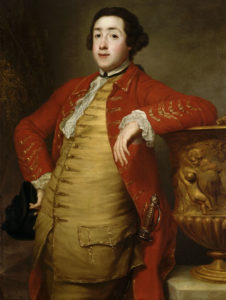
Portrait of Prince Leopold III Friedrich Franz of Anhalt-Dessau.
Wikimedia / Germanisches Nationalmuseum
SWISS STAINED GLASS IN WÖRLITZ
Back home, Prince Franz had the stained glass mounted in the windows of his Gothic House in the Wörlitz country park near Dessau. On his travels to England he had visited the temple at Stowe Landscape Gardens and the house at Strawberry Hill, where he had seen the reuse of old stained glass plates that the English associated with their golden era, the early Middle Ages. In the English style, the prince incorporated the panes into his own building and assigned them – divided by content – to special rooms: the standard-bearers from the Schützenhaus in Zurich adorn the Rittersaal, plates depicting the old confederate freedom with William Tell decorate the Kriegerische Kabinett, and the Geistliche Kabinett features apostles and saints from the creed sequence in the church at Maur.
The historic stained glass plates were framed with expensive yellow and blue clay glass. The windows let in little daylight, and give the rooms a mythical light. In Wörlitz the glass paintings symbolise the independence and freedom of the medieval Swiss confederation, but they also embody the political convictions of the enlightened Prince Leopold III Friedrich Franz of Anhalt-Dessau.
It’s a stroke of luck that the stained glass panes have survived the last 240 years in Wörlitz unscathed. This is some consolation for the fact that the plates are on view not in Switzerland, but in Germany.
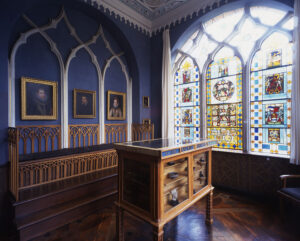
The war gallery (Kriegerische Kabinett) in Wörlitz. Two stained glass plates depicting the Rütli oath can be seen in the centre of the window. They originally came from the old Zurich Schützenhaus and from the Wirtshaus zum Adler in Knonau.
Dessau-Wörlitz Cultural Foundation


